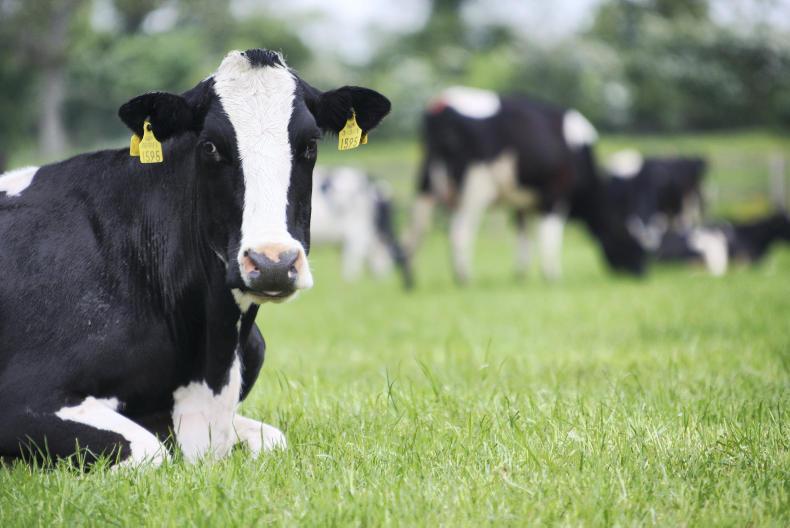Two cows that died within days of each other had previously gorged on windfall apples when they broke into an orchard, Limerick’s Regional Vet Lab (RVL) reported.
A six-year-old dairy cow was submitted to Limerick RVL with a history of being down and bloated.
Another cow in the same herd had died a week earlier. She was also described as having bloat, but the farmer did not investigate her death at the time.
Other cows in the herd had also been bloated and lost their appetite over the previous week.
When the vets in Limerick RVL conducted a post-mortem on the cow, they found she had severe abdominal swelling.
The cow had a perforated stomach ulcer, which had resulted in leakage of her stomach contents and severe localised peritonitis. Peritonitis is a potentially lethal inflammation of the lining of the abdomen.
Old orchard
Further investigation revealed that the dairy herd had been grazing on particularly exposed paddocks during wet weather and a number of cows, including the two cows that had died, had accessed an old orchard adjacent to the grazing paddocks.
It was suspected that they had ingested large numbers of windfall apples, causing acidosis and the clinical signs of bloat.
Although the finding of perforated ulcer in the dead cow could not be directly linked to the herd binging on apples, the vets reported it was possible that a prolonged lack of appetite following rumen acidosis could cause stomach ulcers or worsen pre-existing ulcers.
They had ingested large numbers of windfall apples, causing acidosis and the clinical signs of bloat
Stomach ulcers in cows
Writing in the August 2016 RVL report, the vets noted that ulcers in the abomasum, the last part of the cow’s stomach, are found relatively frequently.
“Although abomasal ulcers can be seen at any time in the production cycle, they are more common in high-yielding cows and mature dairy cows within the first six weeks of lactation,” they noted.
The most likely causes are prolonged periods of exhaustion due to hunger and stress.
These result in the pH of the abomasum staying low for long periods, which damages the lining of the stomach.
This damage may be subclinical or can present with clinical signs such as pain, haemorrhage or perforation.
They advised that in order to reduce the risk of stomach ulcerations, dairy cows should be encouraged to maintain constant dietary intakes throughout lactation, but especially directly after calving.
This would minimise the risk of prolonged low abomasal pH and stress happening at the same time.
Bloat warning: three cows dead on midlands farm
Ragwort poisoning killed five yearlings in three weeks
The causes of mortality in sheep flocks unveiled
Two cows that died within days of each other had previously gorged on windfall apples when they broke into an orchard, Limerick’s Regional Vet Lab (RVL) reported.
A six-year-old dairy cow was submitted to Limerick RVL with a history of being down and bloated.
Another cow in the same herd had died a week earlier. She was also described as having bloat, but the farmer did not investigate her death at the time.
Other cows in the herd had also been bloated and lost their appetite over the previous week.
When the vets in Limerick RVL conducted a post-mortem on the cow, they found she had severe abdominal swelling.
The cow had a perforated stomach ulcer, which had resulted in leakage of her stomach contents and severe localised peritonitis. Peritonitis is a potentially lethal inflammation of the lining of the abdomen.
Old orchard
Further investigation revealed that the dairy herd had been grazing on particularly exposed paddocks during wet weather and a number of cows, including the two cows that had died, had accessed an old orchard adjacent to the grazing paddocks.
It was suspected that they had ingested large numbers of windfall apples, causing acidosis and the clinical signs of bloat.
Although the finding of perforated ulcer in the dead cow could not be directly linked to the herd binging on apples, the vets reported it was possible that a prolonged lack of appetite following rumen acidosis could cause stomach ulcers or worsen pre-existing ulcers.
They had ingested large numbers of windfall apples, causing acidosis and the clinical signs of bloat
Stomach ulcers in cows
Writing in the August 2016 RVL report, the vets noted that ulcers in the abomasum, the last part of the cow’s stomach, are found relatively frequently.
“Although abomasal ulcers can be seen at any time in the production cycle, they are more common in high-yielding cows and mature dairy cows within the first six weeks of lactation,” they noted.
The most likely causes are prolonged periods of exhaustion due to hunger and stress.
These result in the pH of the abomasum staying low for long periods, which damages the lining of the stomach.
This damage may be subclinical or can present with clinical signs such as pain, haemorrhage or perforation.
They advised that in order to reduce the risk of stomach ulcerations, dairy cows should be encouraged to maintain constant dietary intakes throughout lactation, but especially directly after calving.
This would minimise the risk of prolonged low abomasal pH and stress happening at the same time.
Bloat warning: three cows dead on midlands farm
Ragwort poisoning killed five yearlings in three weeks
The causes of mortality in sheep flocks unveiled






 This is a subscriber-only article
This is a subscriber-only article










SHARING OPTIONS: